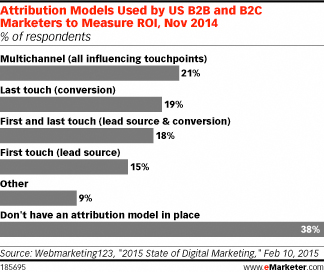Marketers Focus on Making Attribution Data Actionable
March 24, 2015
![]() No one would argue the importance of cross-platform attribution—defined as a method of assigning credit to a particular marketing-driven interaction or other brand touchpoint. But when it comes to pursuing and implementing attribution, the majority of marketers still fall short, according to a new eMarketer report, “Cross-Platform Attribution 2015: Device Identification, Big Data Pose Continued Challenges.”
No one would argue the importance of cross-platform attribution—defined as a method of assigning credit to a particular marketing-driven interaction or other brand touchpoint. But when it comes to pursuing and implementing attribution, the majority of marketers still fall short, according to a new eMarketer report, “Cross-Platform Attribution 2015: Device Identification, Big Data Pose Continued Challenges.”
 As marketers increasingly look to attribution to better understand customers, not just build their media plans and justify budgets, figuring out how to act on cross-platform attribution findings as quickly as possible is on the minds of many.
As marketers increasingly look to attribution to better understand customers, not just build their media plans and justify budgets, figuring out how to act on cross-platform attribution findings as quickly as possible is on the minds of many.
Though blending top-down marketing-mix models with bottom-up path analysis is a popular method of gaining a true holistic view of all paid, owned and earned advertising efforts across digital and traditional media, most find that real-time optimization of intel gained from this approach is still mostly limited to those channels and formats belonging to the digital, bottom-up bucket where impression-level tracking and real-time reporting allows for more real-time optimization.
“The more sophisticated attribution solutions from a media-mix modeling perspective are helping with channel allocation and budget planning, but the adjustments and optimizations are still largely coming from the microattribution that we’re doing on the digital side,” said Allegra Kadet, managing director at Neo@Ogilvy. “Though we’re making progress on making all channels actionable, there’s always going to be some outliers where you can’t connect one channel to another chain of events. I think it’s unrealistic to expect that 100% of all channels will be optimized in real time.”
That’s not to say that some marketers aren’t looking to instill a more real-time optimization approach to some of their traditional media. According to Harpreet Singh, CEO of Kvantum, one of the biggest trends he is seeing among clients is to make traditional offline media more actionable, particularly television.
Singh said more and more marketers hope to identify the effects of TV ad efforts two or three weeks into the campaign, with backup, alternative media plans on deck to optimize and adjust efforts as needed.
Singh said most of those optimizations are happening through spot buys, whether to dial back on future television investment—in favor of digital channels—or augment current TV performance with additional coverage. In using attribution to tie actual in-store sales back to TV and other advertising exposures, clients can then determine which designated market areas (DMAs) are best suited for further TV investment based on the performance of the stores located in the same region.
The importance of attributing and optimizing all actions against actual revenue data such as in-store purchase data is notable. Historically, most digital channel optimization is centered on digital-specific measures such as clicks and conversions, with traditional media modified based on brand-based metrics. Though such metrics might be important indicators of channel-specific success, by and large, they are not the determinants of cross-platform attribution success.
Courtesy of eMarketer































